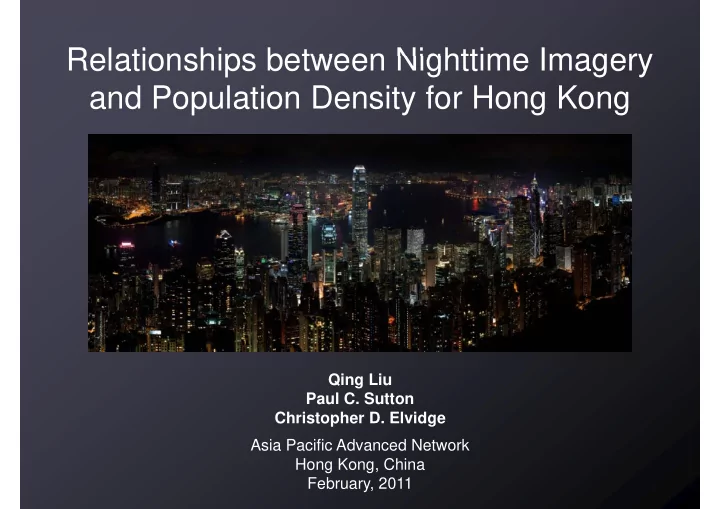

Relationships between Nighttime Imagery Relationships between Nighttime Imagery and Population Density for Hong Kong p y g g Qing Liu P Paul C. Sutton l C S tt Christopher D. Elvidge Asia Pacific Advanced Network Hong Kong, China February, 2011
Outline • Introduction • Data • Methods Methods • Results • Discussion • • Conclusion Conclusion
Introduction • Previous analyses have revealed a striking correlation between city- lights and human population density • Some researches suggested correlation between measures of population or population density and nighttime imagery is low and not statistically significant. y g • DMSP-OLS imagery saturated in most of the areas of high population density. y • ISS photograph provide more information of nighttime lights with finer spatial resolution. • Will ISS photograph produce better model to estimate population for areas with high population density than DMSP-OLS imagery?
Data • Nighttime Imagery - Radiance calibrated DMSP Nighttime Lights 2006 - Hong Kong at Night - Astronaut Photography from ISS 2003 Hong Kong at Night Astronaut Photography from ISS 2003 • • Population Representations P l ti R t ti - 2008 LandScan population grid - 2006 Hong Kong population by administrative district
Radiance calibrated DMSP Nighttime Lights of Hong Kong 2006 (F16) Cloud-free composite derived DMSP-OLS data collected at low, medium and high gain settings. 30 arc-second grid or approximately 1 km 2 at the equator
Hong Kong at Night - Astronaut Photography from ISS 2003.03.10 Spatial Resolution: approximately 90m, estimated to be 6m per pixel
LandScan Population Density of Hong Kong 2008 US Laboratory Department of Energy, Oak Ridge National Laboratory Representing ambient population count per cell 30 arc-second grid or approximately 1 km 2 at the equator
First-Principal Component of ISS photograph
Hypothesis • Nighttime light intensity will positively correlate with the population density • Integration of nighttime lights within district polygons will positively correlate with the total population of those polygons • ISS imagery will produce better model than existing models using DMSP-OLS imagery for estimation of population or population density in high population density area
Methods • Pixel-based - Multi-variate Analysis LandScan, DMSP-OLS, ISS red, ISS green, ISS blue, ISS PC 1 - - Correlation and scatterplot matrix Correlation and scatterplot matrix • Polygon-based - Mean aggregation of ISS PC1 to 1km 2 grid - Zonal statistics: sum of light in each district polygon g p yg - Ordinary least squares regression Independent variable: sum of ISS lights within district polygon Dependent variable: total population for each district
Correlations DMSP- ISS PC1 ISS PC1 ISS R ISS R ISS G ISS G ISS B ISS B OLS OLS LandScan LandScan ISS PC1 1.0000 0.9988 0.9989 0.9851 0.7706 0.6118 ISS R 0.9988 1.0000 0.9976 0.9768 0.7677 0.6116 ISS G 0.9989 0.9976 1.0000 0.9796 0.7709 0.6127 ISS B 0.9851 0.9768 0.9796 1.0000 0.7618 0.5976 DMSP-OLS 0.7706 0.7677 0.7709 0.7618 1.0000 0.6239 LandScan 0.6118 0.6116 0.6127 0.5976 0.6239 1.0000
Scatterplot Matrix
Parameter Estimation • • R 2 = 0.15 R 2 = 0.03 • • p-value = 0.1072 p p p-value = 0.4381 • • Weak linear relationship No linear relationship between between sum of lights from sum of lights from ISS PC1 DMSP-OLS imagery and total imagery and total district district population population
North Tuen Mun Hong Kong Kwun Tong International Airport C Central & West t l & W t Wan Chai Eastern Islands
North Tuen Mun Hong Kong Kwun Tong International Airport C Central & West t l & W t Wan Chai Eastern Islands
Discussion • Overestimation for districts: containing airport, commercial areas, residential areas in new town; with residents of high income and education. g • Underestimation for districts: containing large residential areas and industrial areas; t i i l id ti l d i d t i l with residents of low income and education.
Conclusions • ISS photograph is no better than the DMSP OLS imagery at predicting population density of Hong Kong at the spatial resolution of LandScan. The finer spatial and spectral resolution of the ISS photographs does not increase correlation between nighttime lights and measures of population or population density. l ti l ti d it • Residence-based population at district level of Hong Kong provided by census data are not well modeled by nighttime imagery alone by census data are not well modeled by nighttime imagery alone. • Areas of high ambient population density that are not residential (airports commercial areas etc ) tend to emit more light than (airports, commercial areas, etc.) tend to emit more light than residential areas.
Recommend
More recommend